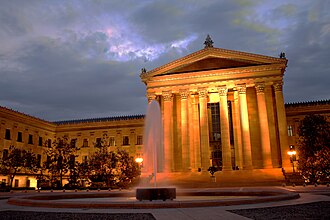Philadelphia Museum of Art
- Address
- 2600 Benjamin Franklin Parkway
- Philadelphia, PA 19130
- Phone
- (215) 763-8100
- Area
- Neighborhood
- Web Page
- http://www.philamuseum.org/
Type of Makom
- Museums Type
- Museum
- Museums Type
- Art museum
Semi-useful stuff
Mikomos rating
Description
The Philadelphia Museum of Art is among the largest art museums in the United States. It is located at the west end of the Benjamin Franklin Parkway in Philadelphia's Fairmount Park. The Museum was established in 1876 in conjunction with the Centennial Exposition of the same year. Originally called the Pennsylvania Museum and School of Industrial Art, its founding was inspired by the South Kensington Museum (now the Victoria and Albert Museum) in London, which grew out of the Great Exhibition of 1851. The Museum, at that time housed in the Centennial Exposition's Memorial Hall, opened its doors to the public on May 10, 1877. While this location was adequate, it was remote from the vast majority of the city's inhabitants.
Construction of the current building began in 1919 when Mayor Thomas B. Smith laid the cornerstone in a Masonic ceremony on the former reservoir land of the decommissioned Fairmount Water Works covering 10 acres (40,000 m2) of ground. The first section was completed in early 1928. The quasi-Greek Revival design was produced by Horace Trumbauer and the firm of Zantzinger, Borie and Medary. The facade of the building is of Minnesota dolomite. The pediment facing the parkway is adorned with sculptures by C. Paul Jennewein depicting Greek gods and goddesses. There is also a collection of griffins, which were adopted as the symbol of the museum in the 1970s. The Museum's building is fondly nicknamed the Parthenon on the Parkway.
The institution describes itself as "one of the largest museums in the United States", and its collections comprise more than 225,000 objects. Though the Museum houses over 200 galleries spanning 2,000 years, it does not have any galleries devoted to Egyptian, Roman, or Pre-Columbian art. This is because a partnership between the Museum and the University of Pennsylvania had been enacted early in the Museum's history. The University loaned the Museum its collection of Chinese porcelain, and the Museum loaned a majority of its Roman, Pre-Columbian, and Egyptian pieces to the University. However, the Museum keeps a few important pieces for special exhibitions.

